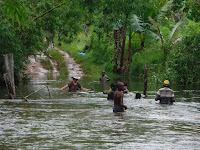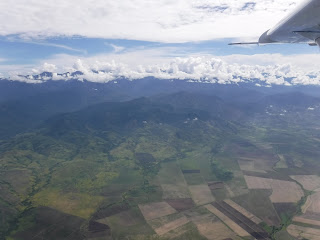I could listen to the Ranmo sing for hours. The melodies are somber. They are not joyless,
just serious like some of our old hymns.
They know life can be hard. They
live it every day. But they know God is
a good father and worship despite hardship.
It took four days to get to Indorodoro. Rain season is not supposed to have started
yet. Our trip began by airplane in the
Eastern Highlands. When we landed at
Moorehead the people there told us the pontoon barge (used to float vehicles
across the river) was sunk (again), and no vehicles could go that way. Fifty kilometers of swamp and flooded rivers
were between us and the village; rain season is not supposed to be here
yet. So we flew to Bensbach, a few
kilometers from the Indonesian border and the western-most river in Papua New
Guinea. The next day we were able to
hire a dinghy which took us as far as Weam.
The trip took several hours following the river through flooded
marshland as flocks of birds flew up and away from the boat. Herons and hawks, rare birds of paradise and
parrots of all kinds kept their distance as the boat made its way through the
marsh. Several hours of travel on the
river and we only passed one village; there is more wildlife out here than
people. It’s hard to discern the difference
between the river and flood land but our boat operator knows it better than I
know my house in the dark.
We arrived at Weam, a government airstrip routinely shut
down due to lack of maintenance. The
Papua New Guinea Defense Force has a unit stationed there but they’ve not been
resupplied or paid in months. They buy
food from the locals and fuel from Indonesia but their cash flow is running
low. After two days in Weam we were able
to pay some locals to go to Sota (Indonesia), to buy fuel for the Defense Force
Land Cruiser. It has no brakes and even
though they are on their second transmission third gear howls like a
banshee. The front drive shaft and axles
have been removed reducing it to two-wheel drive status, but it runs okay as
long as it has fuel. I learned later
that truck is only one year old.
 Half way between Weam and Indorodoro we came to a village
called Gariam. At least now we were in
the same language dialect as Indorodoro and Jessica could communicate clearly
in Ranmo. In Gariam the creek was
flooded to chest deep over the bridge.
The bridge consisted of two logs per tire and we had to feel where they
were in the murky water with our feet.
If the truck could not stay on the logs the water depth was over
head. End of the road; time to walk.
Half way between Weam and Indorodoro we came to a village
called Gariam. At least now we were in
the same language dialect as Indorodoro and Jessica could communicate clearly
in Ranmo. In Gariam the creek was
flooded to chest deep over the bridge.
The bridge consisted of two logs per tire and we had to feel where they
were in the murky water with our feet.
If the truck could not stay on the logs the water depth was over
head. End of the road; time to walk. Because this village was within Jessica’s translation
project the people knew her and were willing to help. After crossing the flooded creek they loaded
our supplies onto the makeshift racks they use on their bicycles and headed for
Indorodoro. The rest of the way was a
mix of flooded road and occasional dry.
Though mostly not more than ankle deep the weather shifted from monsoon
rain and wind that we could hardly talk over to dead calm sun and steam rising
from the road, all within a few hours.
That last stretch took five hours to hike. We had finally reached Indorodoro where we
could begin our village stay.
Because this village was within Jessica’s translation
project the people knew her and were willing to help. After crossing the flooded creek they loaded
our supplies onto the makeshift racks they use on their bicycles and headed for
Indorodoro. The rest of the way was a
mix of flooded road and occasional dry.
Though mostly not more than ankle deep the weather shifted from monsoon
rain and wind that we could hardly talk over to dead calm sun and steam rising
from the road, all within a few hours.
That last stretch took five hours to hike. We had finally reached Indorodoro where we
could begin our village stay.
The funeral and hauskrai consumes village life for some time
afterward.
The people’s grieving tradition involves loud and prolonged
wailing. It goes on for hours over the
course of several days and can be heard throughout the entire village. As family members arrive from distant
villages they begin their wailing at the edge of the village and continue for
quite some time after reaching the body.
The mourning in this area sometimes takes on a musical
temperament. Rather than voiceless sobs,
loved ones sing out the things they miss or activities they used to do with the
deceased. Ruth’s father banged the
skulls of cassowary and deer together while bobbing along similar to a
traditional dance. He was crying out “Daughter!
These are the meats I used to prepare for you. Cassowary and deer I used to feed you.”
Ruth’s elderly aunt carried a yere on her back, a woven basket full of garden produce. She sang about how they used to plant and
harvest together and that her brother’s daughter would no longer be able to
help.
All of Ruth’s loved ones had an attribute, a story, a
song. And they were all expressed
simultaneously in a cacophony of singing, wailing and sobs. The coffin was being sawn and hammered
together just a few feet away, repurposed from a wooden table. And the sound was a part of the chaos. Just behind the house, a few feet in the
other direction, they dug the grave, water and soupy mud flowing in as fast as
they could scoop it out. Little boys
bailing water, men digging with shovels.
Some threw themselves over the body or coffin or grave. And the crying continued long into the night.
There are missionaries who claim these practices should be
abandoned within communities which claim to be Christian. They liken it to one who grieves without hope;
a pagan ritual. I disagree. These traditions show that the deceased is
loved, that they are missed and that the person is valued. They show
these things. As Westerners we only say these things. The Ranmo could say that our lack of apparent
emotion indicates a lack of love for the deceased. They could claim that our stoicism is
indifference to pain or death or suffering.
They could say that if we love the person we should show that we love
them and not just say it. But they don’t
say any of those things. They say, “You are not from here. Your ways are not like our ways. You grieve the way you grieve and we grieve
the way we grieve. And that is okay.”
There is much to be learned coming to a place like
Indorodoro. And we are not always the
teachers.


















